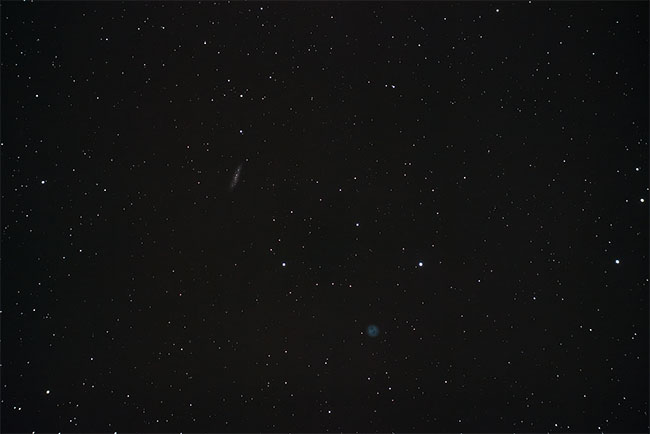M97 & M108
 This was the longest exposure for this night and we managed to capture both the owl nebula (M97) and the surfboard galaxy (M108). Both objects came out pretty nicely. See more information here for the night this picture was taken.
This was the longest exposure for this night and we managed to capture both the owl nebula (M97) and the surfboard galaxy (M108). Both objects came out pretty nicely. See more information here for the night this picture was taken. 
 A planetary nebula is a kind of emission nebula consisting of an expanding glowing shell of ionized gas ejected from old red giant stars late in their lives. The word 'nebula' is Latin for mist or cloud and the term 'planetary nebula' is a misnomer that originated in the 1780s with astronomer William Herschel because when viewed through his telescope, these objects appeared to him to be newly forming planetary systems. Herschel's name for these objects was adopted by astronomers and has not been changed. They are a relatively short-lived phenomenon, lasting a few tens of thousands of years, compared to a typical stellar lifetime of several billion years.
A planetary nebula is a kind of emission nebula consisting of an expanding glowing shell of ionized gas ejected from old red giant stars late in their lives. The word 'nebula' is Latin for mist or cloud and the term 'planetary nebula' is a misnomer that originated in the 1780s with astronomer William Herschel because when viewed through his telescope, these objects appeared to him to be newly forming planetary systems. Herschel's name for these objects was adopted by astronomers and has not been changed. They are a relatively short-lived phenomenon, lasting a few tens of thousands of years, compared to a typical stellar lifetime of several billion years. ― source and more information wikipedia
― source and more information wikipedia
Date: 2014-02-25 / 22:39:00 UTC
Location: Ekerö, Sweden
Temperature: 2 °C
Telescope: William-Optics Megrez 88FD
Camera: Canon 600D
ISO: 800
Mount: Skywatcher NEQ6 Pro Synscan
Exposure time: 250 X 30 sec
Reducer/flattener: William-Optics 0.8X reducer/flattener (P-FLAT-F6)
Other info: Autoguided with 50mm guidescope and QHY5-II. Used PHD2 (2.2.1) guiding software.
Processing: Stacked and darks-subtracted in DeepSkyStacker. Processed in Photoshop CS6.




 2014-02-25
2014-02-25 